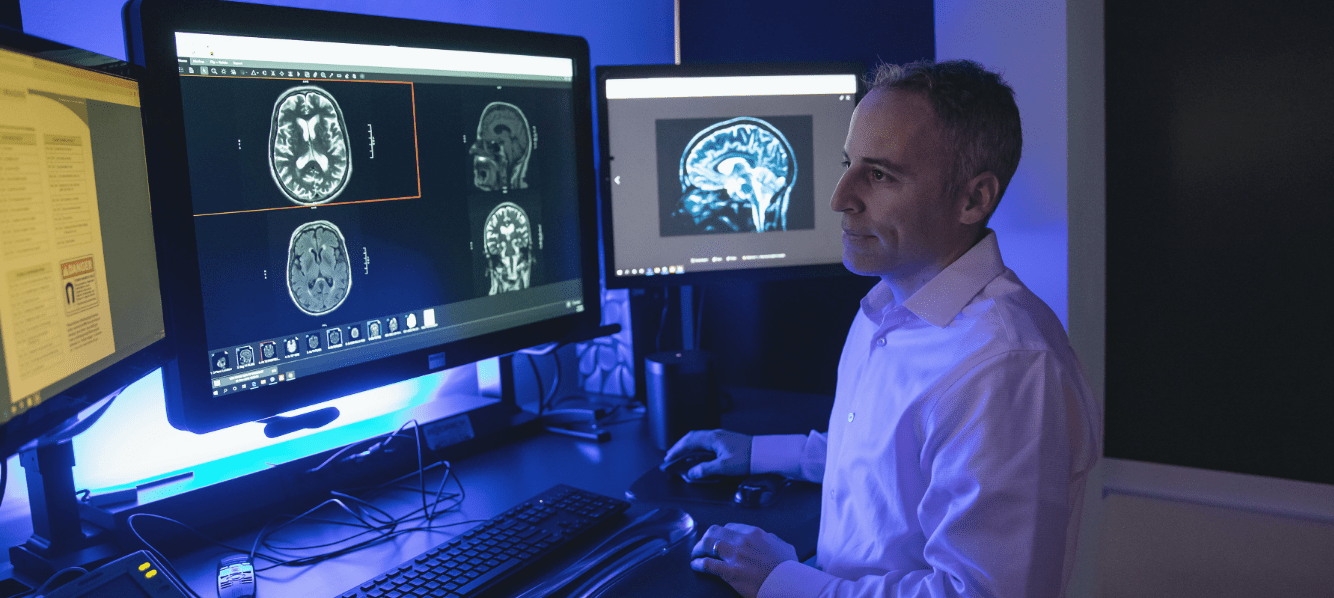CASE STUDIES

This is a brief description of AI/ML Development Case Studies. A series of compelling case studies showcasing the practical applications of Artificial Intelligence (AI) and Machine Learning (ML) development. Each case study highlights how organizations leveraged advanced AI/ML technologies to solve complex problems and achieve significant business outcomes. Let's delve into these transformative examples of AI/ML in action.
Read MoreCase Details
"Case 1: Predictive Maintenance for Manufacturing Equipment Problem: A manufacturing company experienced frequent breakdowns in its machinery, leading to production delays and increased maintenance costs. Solution: Implementing a predictive maintenance system using machine learning algorithms. Data from sensors embedded in the machinery was collected and analyzed to identify patterns indicative of potential failures. Predictive models were developed to forecast equipment failures before they occurred, allowing for proactive maintenance actions to be taken. Results: The predictive maintenance system significantly reduced unplanned downtime and maintenance costs. By addressing issues before they escalated into major breakdowns, the company improved operational efficiency and productivity. Case 2: Personalized Recommendation Engine for E-commerce Platform Problem: An e-commerce platform struggled to provide relevant product recommendations to its customers, resulting in low conversion rates and customer engagement. Solution: Deploying a recommendation engine powered by machine learning algorithms. Customer behavior and purchase history data were analyzed to generate personalized product recommendations for each user. The recommendation engine utilized collaborative filtering and content-based filtering techniques to suggest products based on similar user preferences and item attributes. Results: The personalized recommendation engine improved the user experience by presenting relevant product suggestions, leading to higher click-through rates, increased sales, and enhanced customer satisfaction. The platform saw a significant uplift in revenue and customer engagement metrics. Case 3: Medical Image Analysis for Disease Diagnosis Problem: Radiologists faced challenges in accurately diagnosing diseases such as cancer from medical imaging scans, leading to potential misdiagnoses and delays in treatment. Solution: Developing deep learning models for medical image analysis. Convolutional neural networks (CNNs) were trained on large datasets of medical images to identify patterns indicative of specific diseases, such as tumors in MRI or CT scans. The models were designed to assist radiologists by providing automated image analysis and diagnostic predictions. Results: The AI-powered medical image analysis system improved diagnostic accuracy and efficiency. By assisting radiologists in interpreting imaging scans, the system enabled earlier detection of diseases, improved treatment planning, and better patient outcomes. Additionally, it reduced the workload on healthcare professionals and expedited the diagnosis process."

Explore our Software Development Case Studies, showcasing our expertise in crafting robust and scalable software solutions. Dive into real-world examples where we've implemented innovative software strategies to streamline processes, enhance productivity, and drive business growth. Discover how our tailored software development services have empowered organizations to achieve their unique goals effectively.
Read MoreCase Details
"Case 1: Enterprise Resource Planning (ERP) System Implementation - A large manufacturing company struggled with disparate systems for managing various business functions such as inventory management, procurement, human resources, and finance. This led to inefficiencies, data silos, and difficulties in decision-making Problem: A large manufacturing company faced challenges due to disparate systems for managing core business functions like inventory, procurement, HR, and finance. This resulted in inefficiencies, data silos, and hindered decision-making processes. Solution: Implementing an Enterprise Resource Planning (ERP) system integrated all business processes into a unified platform. This streamlined operations, improved data visibility, and facilitated seamless communication across departments. Results: The ERP system implementation led to enhanced operational efficiency, reduced manual effort, and improved decision-making. By centralizing data and processes, the company achieved better resource utilization, cost savings, and increased agility in responding to business needs. Case 2: Healthcare Management Software Development - A healthcare facility faced challenges in managing patient records, appointment scheduling, billing, and compliance with regulatory requirements using manual paper-based processes. This resulted in errors, inefficiencies, and patient dissatisfaction Problem: A healthcare facility grappled with manual paper-based processes for patient record management, appointment scheduling, billing, and regulatory compliance. These outdated methods led to errors, inefficiencies, and patient dissatisfaction. Solution: Developing a comprehensive Healthcare Management Software addressed these challenges by automating record-keeping, scheduling, billing, and ensuring compliance with regulatory standards. The software provided a centralized platform for efficient data management and streamlined workflows. Results: The Healthcare Management Software significantly improved operational efficiency, accuracy in record-keeping, and patient satisfaction. By automating key processes, the facility reduced administrative burdens, minimized errors, and enhanced compliance with regulatory requirements, ultimately delivering better patient care. Case 3: Customer Relationship Management (CRM) System Enhancement - A sales-driven organization faced challenges in managing customer relationships, tracking sales activities, and analyzing customer data using its existing CRM system. The system lacked customization, scalability, and integration with other business tools Problem: A sales-driven organization encountered difficulties in effectively managing customer relationships, tracking sales activities, and analyzing customer data due to limitations in its existing CRM system. The system lacked customization, scalability, and integration capabilities with other business tools. Solution: Enhancing the CRM system involved customizing it to meet the organization's specific needs, improving scalability to accommodate growing data volumes, and integrating it with other essential business tools such as marketing automation platforms and analytics software. Additionally, user training and support were provided to ensure successful adoption. Results: The enhanced CRM system enabled the organization to better manage customer relationships, track sales activities, and leverage customer data for strategic decision-making. With improved customization, scalability, and integration capabilities, the organization experienced increased efficiency, productivity, and sales performance, driving overall business growth and success."

Discover our DevOps Case Studies, illustrating our expertise in implementing DevOps practices to accelerate software delivery and improve operational efficiency. Explore real-world scenarios where we've transformed traditional development processes into agile, automated workflows. Witness how our DevOps solutions have enabled organizations to achieve continuous integration, delivery, and deployment, fostering collaboration and innovation across development and operations teams.
Read MoreCase Details
"Case 1: Streamlined Infrastructure Scaling - Implementing Robust Infrastructure Automation to Ensure Seamless Scalability and Growth Problem: A growing e-commerce platform struggled to scale its infrastructure to handle increasing traffic during peak periods, leading to performance degradation and occasional outages. Manual provisioning of resources was time-consuming and prone to errors, limiting the company's ability to meet customer demand and stay competitive in the market. Solution: To address these scalability challenges, the company implemented infrastructure automation practices using tools like Ansible, Puppet, and AWS Auto Scaling. These tools enabled the automation of resource provisioning, configuration, and management tasks, ensuring that the infrastructure could dynamically adjust to fluctuating traffic patterns. Continuous monitoring and alerting solutions were also deployed to detect and respond to performance issues in real-time. Results: The implementation of infrastructure automation led to seamless scalability, allowing the e-commerce platform to handle fluctuations in traffic demand without experiencing performance degradation or downtime. The company achieved improved performance, reliability, and uptime, leading to enhanced customer satisfaction and increased sales revenue. Operational overheads were reduced, and the IT team gained more time to focus on strategic initiatives. Case 2: Improving Software Delivery Efficiency - Implementing DevOps for Continuous Delivery and Deployment Automation Problem: A software development company faced challenges in deploying new features and updates to its application due to manual and error-prone deployment processes. This resulted in longer release cycles, increased downtime, and difficulties in maintaining version control. Solution: We implemented a DevOps culture and toolchain to automate the entire software delivery process. This included the adoption of Continuous Integration (CI) and Continuous Deployment (CD) pipelines using tools like Jenkins, Docker for containerization, and Kubernetes for orchestration. Additionally, infrastructure as code (IaC) practices were introduced using Terraform to provision and manage cloud resources. Results: The DevOps implementation led to significant improvements in release frequency, with new features and updates being deployed to production seamlessly and frequently. Downtime was reduced, and the development team gained more time to focus on delivering value-added features. The company saw an increase in customer satisfaction due to faster response to feedback and a more stable application environment. Case 3: DevOps for Security and Compliance - Implementing Robust DevOps Practices to Ensure Enhanced Security Measures and Compliance Standards Across the Software Development Lifecycle Problem: A financial services firm faced challenges in maintaining security and compliance standards while rapidly deploying software updates to its applications. Manual security checks and audits were time-consuming and often led to delays in release cycles, impacting the company's agility and competitiveness in the market. Solution: To address these security and compliance challenges, the company embraced a DevSecOps approach, integrating security practices into the software development lifecycle (SDLC). Automated security testing tools such as SonarQube and Veracode were adopted to scan code for vulnerabilities and compliance violations. Additionally, infrastructure security was strengthened using tools like HashiCorp Vault and AWS IAM to manage secrets and access control policies. Results: The implementation of DevSecOps practices enabled the financial services firm to achieve a balance between security and agility. Security vulnerabilities and compliance issues were detected and remediated earlier in the development process, reducing the risk of data breaches and regulatory fines. The company's reputation for security and trustworthiness improved, leading to increased customer confidence and business growth."

Enter the realm of Web App Development through our insightful case studies, highlighting our commitment to building dynamic and responsive web applications. Explore diverse projects that showcase our proficiency in leveraging the latest web technologies to create robust and user-friendly web solutions. Experience firsthand how our web development services have empowered businesses to establish a strong online presence, drive engagement, and achieve sustainable growth.
Read MoreCase Details
"Case 1: E-commerce Platform Enhancement: An existing e-commerce platform lacked user engagement and had a high bounce rate due to slow loading times and a clunky user interface Problem: An existing e-commerce platform faced significant challenges related to user engagement and retention. The platform suffered from slow loading times, resulting in a high bounce rate. Additionally, users found the interface cumbersome and unintuitive, leading to frustration and decreased sales. Solution: The development team optimized the e-commerce platform by improving loading times and redesigning the interface. They implemented performance enhancements such as code refactoring and image compression, along with a revamped user interface using React.js. Analytics tools were integrated to monitor user behavior continuously. Results: The enhancements led to significantly faster loading times and a more intuitive user interface, resulting in reduced bounce rates and increased conversions. Simplified navigation and streamlined checkout processes contributed to improved user engagement and higher sales, making the platform more competitive in the market. Case 2: Online Learning Management System (LMS): A university wanted to transition its traditional classroom-based courses to an online platform to cater to remote learners and provide flexible learning options Problem: The university faced challenges in accommodating remote learners and providing flexible learning options due to its reliance on traditional classroom-based courses. The lack of an online platform limited access for students unable to attend classes in person. Solution: The university implemented an Online Learning Management System (LMS) to transition its courses to an online platform. The LMS offered a centralized hub for course materials, assignments, discussions, and assessments. Features such as video lectures, interactive quizzes, and discussion forums facilitated engaging and flexible learning experiences. Results: The adoption of the LMS enabled the university to reach a broader audience of remote learners and provide flexible learning options. Students benefited from access to course materials anytime, anywhere, leading to increased engagement and satisfaction. The LMS also improved administrative efficiency by automating processes such as grading and course management, resulting in streamlined operations and reduced workload for faculty. Case 3: Real-Time Collaboration Tool: A distributed team of professionals in different locations struggled to collaborate effectively on projects due to communication barriers and reliance on outdated tools Problem: A distributed team of professionals faced challenges in collaborating effectively on projects due to communication barriers and the use of outdated tools. The lack of real-time collaboration hindered productivity and coordination among team members spread across different locations. Solution: The implementation of a Real-Time Collaboration Tool addressed the team's challenges by providing a centralized platform for seamless communication and collaboration. Features such as instant messaging, file sharing, task assignment, and real-time document editing enabled team members to work together efficiently regardless of their geographic locations. Results: The adoption of the Real-Time Collaboration Tool significantly improved team productivity and coordination. With enhanced communication capabilities and real-time access to project resources, team members were able to collaborate more effectively, leading to faster decision-making, reduced project delays, and improved overall project outcomes."

IoT development means combining hardware parts and software programs in such a way that the final product could monitor specific values, collect and transfer data, analyze given data and cause the physical device to act correspondingly. Creating such systems is a true challenge. Moreover, the Internet of Things has already been transformed into an industry in its own right, so the need for reliable and comprehensive developer toolkits has also increased.
Read MoreCase Details
"Case 1: A mobile game studio aimed to increase player retention and engagement for its flagship title, which was experiencing a decline in active users due to repetitive gameplay and lack of new content updates Problem: A mobile game studio faced a decline in player retention and engagement for its flagship title due to repetitive gameplay and a lack of new content updates, leading to a decrease in active users. Solution: We implemented new features and content updates to refresh the gameplay experience and re-engage players. This involved introducing new levels, characters, challenges, and social features to enhance the overall gaming experience and encourage continued engagement. Results: The introduction of new features and content updates revitalized the gameplay experience, resulting in increased player retention and engagement. The studio observed a surge in active users, longer play sessions, and positive feedback from players, ultimately leading to improved game metrics and revenue generation. "